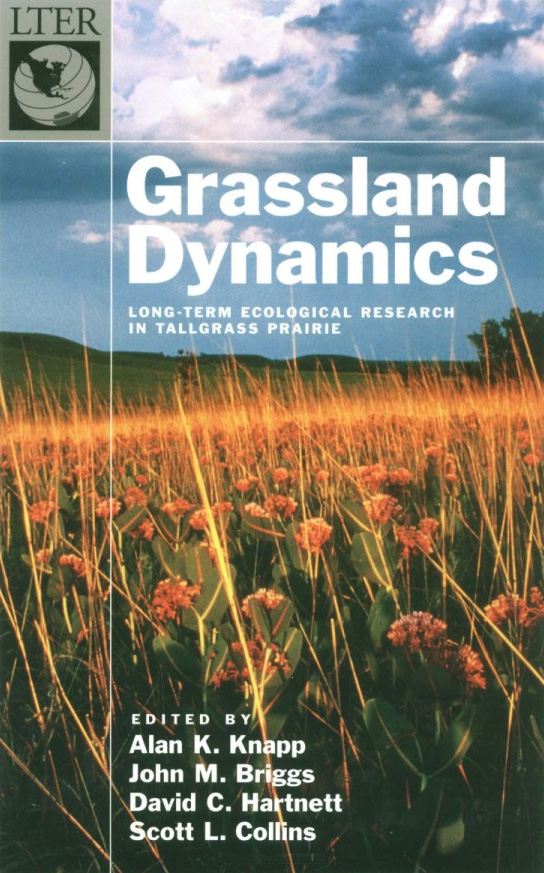Author

Alan K. Knapp
John M. Briggs
David C. Hartnett
Scott L. Collins
This is the first volume in the Long-Term Ecological Research (LTER) Network Series.
Established in 1980, the LTER program is exploring a wide variety of biomes characteristic of the United States and developing a baseline for ecosystem dynamics over long time periods and broad spatial scales. The volumes in this series will include both comprehensive reviews of research from particular sites and topical overviews which use data from many sites to examine important questions in ecology.
This volume, which focuses on the Konza Prairie in northeastern Kansas, is a synthesis of over 15 years of research in pristine tallgrass prairie. It gives a comprehensive site description and summarizes the key long-term studies that form the basis for the Konza Prairie Long-Term Ecological Research Program. It then presents a synthesis of the many research areas involved and develops a foundation for future ecological studies in tallgrass prairie.
With over 150 figures and tables, chapters that encompass microbial through landscape scales, and an emphasis on lessons learned from long-term studies, this volume provides a unique and comprehensive perspective on the structural and functional ecology of the grassland ecosystem that once covered most of central North America.
Review
“This well-written, comprehensive review of the pristine tallgrass Konza Prairie in northeastern Kansas not only examines the pattern and control of primary production, organic matter accumulation as well as inorganic mineral input and movement into the soils and ground water, and the spatial and temporal distribution of populations and their disturbance; it also analyzes how feedback mechanisms existing among biotic and abiotic factors ameliorate or exacerbate biotic responses. . . . A valuable resource for students of ecology because it synthesizes many years of research that are being used to develop a baseline of ecosystem dynamics on broad spatial and temporal scales. Undergraduates through professionals.” — Choice
“The central theme [of this book] is that prairie is primarily a nonequilibrium system where changes in fire, grazing and climate over the years bring about a switching among limiting factors that alter the diversity, composition and production of the terrestrial and aquatic ecosystems. This theme represents a developing paradigm shift in ecology. . . . This book is a successful synthesis of the research at Konza [Prairie Natural Research Area in Kansas], linking population, community and ecosystem levels and showing the complexity of ecosystem dynamics. It is a fitting tribute to the great insight and accomplishments of long-term and integrated ecological research. Although the picture that emerges is complex, it is also predictable, which gives hope for understanding, preserving and restoring prairies. I highly recommend ‘Grassland Dynamics’ because of its breadth and attention to ecological theory in a management context.” — Plant Science Bulletin
“This volume is the first of a planned series on Long-Term Ecological Research (LTER). . . . The nucleus of the Konza prairie was 371 hectares purchased by The Nature Conservancy in 1976. This was increased to 3487 hectares by 1980. In this volume 30 authors summarize the background and the ongoing research in 17 chapters. . . . Much of the research has established baseline data on geology, soils, hydrology, microbiology, and the makeup of plant and animal communities. . . . The overall hypothesis of the authors that this grassland is a nonequilibrium system is adequately supported by the data. The 150 figures and tables will bear careful study as well as samplings from the 40 pages of references. The authors are quite correct in feeling that their data and interpretation will help in the future management of the world’s biological resources. This includes the prediction and ameliorization of global climate changes.” — Journal of Environmental Quality
“This compendium of information about climate, geology, history, fauna (even the aquatic fauna) and flora of the Konza prairie in the Flint hills of Kansas is filled with technical detail and jargon, creating a breadth of coverage that is a crucial strength of the book. Seventeen chapters fall into the following sections: physical environment, terrestrial populations, aquatic ecology, ecosystem processes, and a view of the future. Rather than bibliographies for each chapter, a more useful single list of references was provided for the entire book. . . . The focus of this long-term ecological research site has been the role of fire frequency in determining the flora, fauna and especially nitrogen cycling. . . . Frequently it is noted that research creates more questions that it answers. The studies at Konza prairie have shown that population dynamics and nutrient cycling are much more dependent on extreme, localized events than was generally appreciated.” — The Quarterly Review of Biology
“This book summarizes the wealth of new information on tallgrass prairie ecology gleaned from over fifteen years of intensive study of the Konza Prairie Research natural Area in the Flint Hills of northeastern Kansas. . . .Upper-level undergraduate and graduate students, teachers, and managers of tallgrass prairie should all find it a valuable resource. . . .the naturalist and prairie enthusiast wanting more than a superficial treatment of prairie ecology ought to find much here to satisfy their interests.” — Great Plains Research
Number of pages: 75
Format: Hardback
Number of illustrations: 386
Dimensions: 6-1/8 x 9-1/4
Price: 75
Availability: In Stock
Buy It Now!: http://www.amazon.com/dp/0195114868/ref=as_li_ss_til?tag=longtermecolo-20
Publication Date: 1997-12










